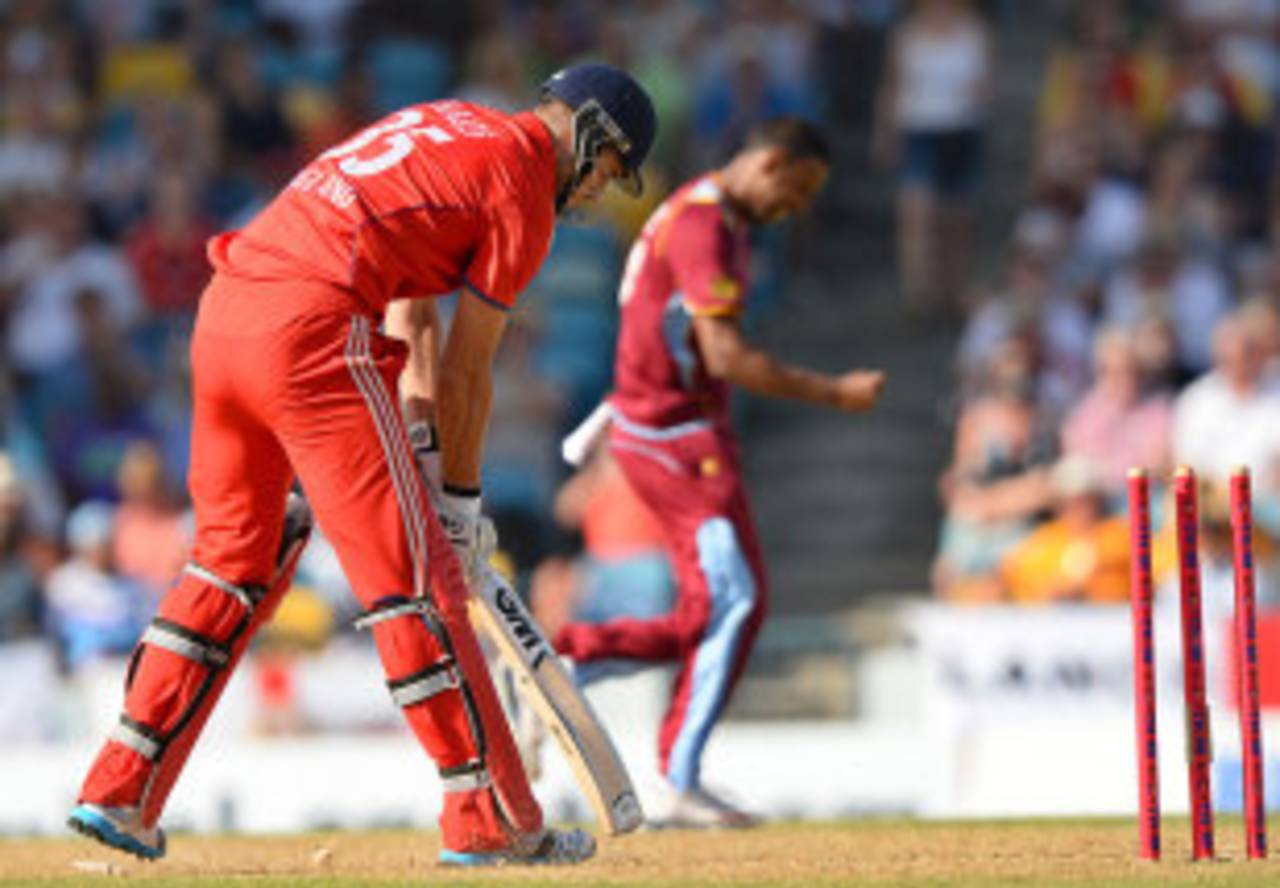Out-thought, out-played and out-gunned, England endured a chastening start to the T20 series against West Indies in Barbados.
It was not just that England were well beaten that will disturb them. It was that they were well beaten largely due to their enduring struggles against spin bowling. Bearing in mind that they will be playing the World T20 on Bangladesh pitches where spin is expected to dominate, then it is hard to be optimistic about their chances.
It would be an exaggeration to suggest that this match was decided before it even began. But not much of an exaggeration. While West Indies' three spinners bowled 10 overs and claimed 6 for 46, England selected four fast-medium bowlers who bowled their 12 overs for 128 without taking a wicket. They picked only one spinner and he was, by some distance, their best bowler. They simply misread the pitch.
But even if England had stacked their side with spinners, even if they had bowlers to compare to the quality of Sunil Narine, they would still have to have batted far better to have given themselves any chance of victory.
As it was, they batted like schoolboys. While Ben Stokes, head in the air and swinging like a punch-drunk boxer, might be forgiven on the grounds of inexperience,
Luke Wright, playing his 100th international and becoming the second England player (after Stuart Broad) to reach 50 T20I caps, has no such excuse. He has now failed to reach double-figures in his last eight international innings and, on this tour, his scores have been 1, 0 and 0. That is not a sustainable record for a specialist No. 3 batsman. While Wright might have a future on quicker surfaces in Australia, it is hard to see how he will flourish in Bangladesh.
In the three ODIs in Antigua, England were largely able to see-off the spinners. They were able to accept that Narine would deliver his overs frugally and simply play him out and plunder the weaker bowlers. But here, in the shorter format, they were further burdened by the presence of the top-spin of
Samuel Badree and knew they could not afford to simply accumulate for eight overs. Had Narine been able to complete his allocation of overs - he was obliged to leave the pitch after sustaining an injury in the field - then the margin might well have been even larger.
While the likes of Dwayne Smith and Chris Gayle were able to thrash fairly decent deliveries over the boundary, England are more reliant on bowler error to match such strokes. They have come to a gunfight armed with a catapult
It is far from the first time that England teams have looked clueless against spin bowling. Perhaps due to the largely one-dimensional character of the pitches that dominate in county cricket, or perhaps due to the inflexible attitude that endures towards 'mystery' spin in the UK, young England players react to exposure to bowlers such as Narine with something approaching horror. It has been a long-standing weakness in the English system.
There have been improvements in recent years. But there are few members of the Test squad that triumphed in India in this limited-overs squad, so it appears that, each generation, England have to return to square-one in their struggle against spin. In the longer term, they would be well served allowing more turning pitches in the County Championship and encouraging more unorthodox bowlers to develop their art. At present, the cleft foot of the puritanical action-police continues to hold England back in this regard.
England did not bowl badly. While West Indies recorded their
highest T20I score at the venue - only Sri Lanka and Australia have scored more here - it was more of a result of a true pitch almost perfect for this form of the game and a batting line-up blessed with power than it was poor bowling. England simply lacked the slow-bowling options that might have made life more difficult.
Indeed, had James Tredwell accepted a chance - a chance somewhat harshly described by Broad as "a dolly" - offered by Marlon Samuels when he had 43, West Indies might have restricted to something around 150. As it was, Samuels thrashed the final five deliveries in the same Jade Dernbach over to the boundary and West Indies were all but out of reach.
England have little such fire-power in their own batting. While the middle-order of Eoin Morgan, Jos Buttler and Ravi Bopara, must be considered dangerous, their line-up does not compare to the power present in the West Indies' top seven. While the likes of Dwayne Smith and Chris Gayle were able to thrash fairly decent deliveries over the boundary, England are more reliant on bowler error to match such strokes. They have come to a gunfight armed with a catapult and may well have missed a trick by overlooking powerful T20 batsmen such as Darren Stevens and Steven Crook, whose skiddy pace might also have proved especially effective in Bangladesh.
There was even worse news for England at the end of the game.
Broad announced that he will not play the final two T20s in order to rest a knee problem that might be described as chronic, while it emerged that Morgan's knee injury is continuing to bother him. The England camp deny it, but both must be considered doubts for the World T20 and Broad, who is having a "fourth or fifth" injection on his troublesome knee, is clearly in need of some time off. Whichever way you look at it, England are facing an uphill struggle in Bangladesh.
George Dobell is a senior correspondent at ESPNcricinfo
